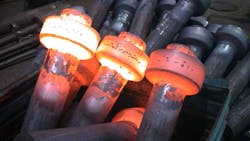A punch- in-die alignment system was being used. For the perform blows, the preformed cones were out of line by about 1/16 in. The lateral shearing action that occurred when the rugged finish die pulled the out of line preform back into alignment seemed to be the culprit in that case. Once the upset ratio was reduced and the tool alignment was corrected for the first two blows, the problem was resolved. You may be seeing the results of a similar problem.
For more than 40 years H. James Henning held key technical positions in the forging industry, including as director of technology for the Forging Industry Association, and as president of Henning Education Services, a Columbus, OH, firm specializing in customized education and training in forging technologies.
Guidelines and recommendations offered in this column are based on information believed to be reliable and are supplied in good faith but without guarantee. Operational conditions that exist in individual plants and facilities vary widely. Users of this information should adapt it, and always exercise independent discretion in establishing plant or facility operating practice.
About the Author
H. James Henning
In all, Jim spent 44 years as a technician, engineer, and supervisor in the forging industry prior to his retirement, including nine years as technical director of the Forging Industry Assn.
Upon his retirement from FIA in 1996, Jim formed Henning Educational Services Inc. There, he filled a problem-solving role for forgers and other manufacturers seeking solutions to process and organizational issues. He shared his expertise on hot, cold, and warm forging, on tool design principles, process and equipment selection, and productivity and quality improvements.
